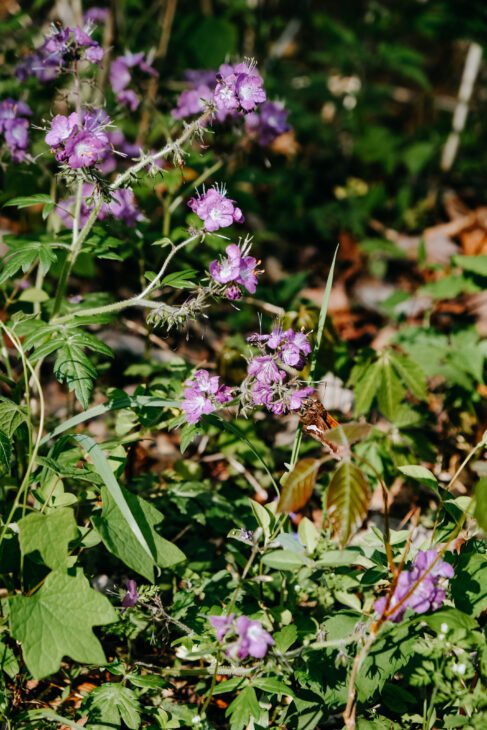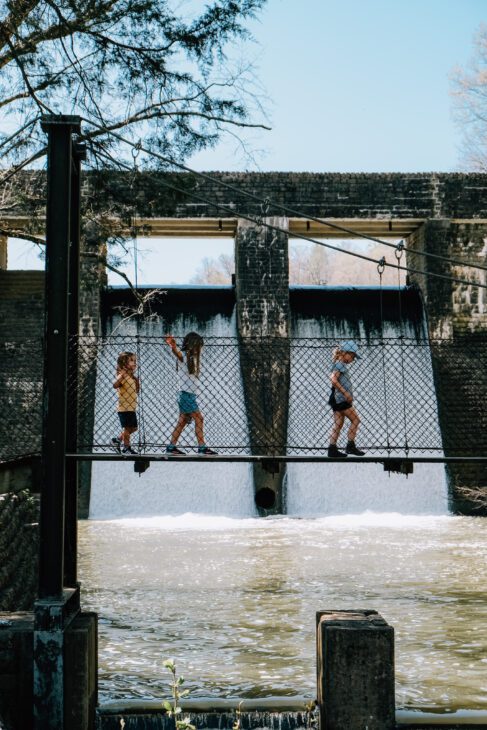This post was freelanced for Tennessee State Parks, originally published on their blog as “5 Ways to Enjoy Standing Stone State Park.” I was financially compensated for this post.
For centuries, a 12-foot high stone sculpture stood in Putnam County, its exact origin puzzling residents and visitors. It’s been described as “sphinx-like,” more precisely as “a big gray dog in a sitting position,” and has been dated to over 1,500 years old. When railroad workers blasted a zone through the area in the late 1800s, the statue was reduced to fragments, and one 4-foot piece was incorporated into a monument that still stands in Monterey.
Though its story may be lost to time, the mystery of the monolith lingers on, preserved in the name of Standing Stone State Park, an 855-acre retreat in nearby Overton County nestled in the surrounding 11,000-acre Standing Stone State Forest on the Cumberland Plateau. It’s one of Tennessee’s earliest state parks, established in 1939 as a Works Progress Administration project to revive eroded lands and create a recreation area, just two years after the founding of the Tennessee State Park system. The park contains a true, often contrasting, assortment of landscape–steep ridges and rocky inclines; dense forests and great, wide meadows; ambling brooks and a quiet, lazing lake. With this variety, Standing Stone offers an array of outdoor activities that my family explored during a camping trip this spring.
Spring, in fact, is the perfect time to visit Standing Stone. Wildlife is roused from winter sleep, bursting out of hibernation and onto display. The weekend of our April visit, we were blessed with dry skies and warm sun. Even luckier, our stay coincided with the park’s annual Spring Nature Rally, offering an amazing lineup of workshops, lectures, guided hikes, and other activities for all ages. No matter when you visit Standing Stone, though, there is much to enjoy in every corner of the park.


1. Sleep under the stars.
When you are tent-camping like my family, spring is the ideal time of year to sleep outside; the days are (hopefully!) warm, the nights cooler, and the humidity non-existent. The park has 36 sites in its campground that hold both tents and trailers. Each site has electrical and water hookups, as well as a picnic table and fire ring.
The campground sits among small rolling hills with the bathhouse crowning the top. Campsites are tucked into the valleys between roads creating clusters of privacy and noise barriers. It’s a community during the day with kids on bikes, dogs out for walks, and conversation carrying from one campsite to another. As night falls, the communal space shifts towards the individual as sites are enshrouded by darkness. Movement stills, and the noise from voices and electronics quiets as nature takes center stage.
Our families cooked hot dogs, foil pack meals, and, eventually, S’mores around the campfire. As visibility reached only to the edges of the firelight, we shone flashlights into the trees above to explore their dark depths. Through their branches, we could see a sky full of stars that appeared to be twinkling, but on closer look, we discovered the glimmers were coming not from stars but from the season’s first fireflies, resting at the heights of our surrounding pines. Though the park’s main road ran along the back of our campsites, we blissfully heard nothing overnight except the cooing of birds and occasional loud screech of an owl.
(If camping isn’t your thing, you can still enjoy a peaceful overnight stay in one of the park’s 20 rustic or deluxe cabins!)



2. Search for native wildflowers.
Standing Stone is often cited as one of the best locations in the state to hunt for native spring wildflowers. Part of it is due to geographic luck; the park boasts a variety of habitats (meadows, woodlands, and wetlands), and it has a good combination of soil composition, climate variations, and topography. But according to Park Manager Shawn Hughes, human efforts have a hand in it, too. “Years of management practices, like controlled burns, invasive species control, and habitat restoration efforts have played a crucial role in promoting our wildflower diversity. It’s the perfect combination of protection, habitat diversity, and ecological management that makes it such a hotspot for so many wildflower enthusiasts each year.”
With copies of the Tennessee Spring Wildflower Bingo card in hand for our hunt, our party joined a guided tour with retired State Naturalist Randy Hedgepath to seek wildflowers along Beach Road, east of Overton Lodge. The cascades of Morgan Creek burbled alongside the road as we peered into the vegetation. Thank goodness for the guidance–without it, we never would have identified the prairie trillium, fernleaf phacelia, and wild geraniums we spotted.



3. Enjoy the water.
Like many New Deal-era state parks, Standing Stone was built with a man-made lake to provide recreation opportunities to the area; there are lots of water-based activities on both sides of the impressive WPA-constructed stone dam to enjoy. The dam itself is worth a visit, too; if entering the park from the south, you’ll enjoy a drive across the one-lane road that runs atop of it.
We spent much of a morning on the “dry side” of the dam where the waterfall rushing off this towering, historical feat of engineering serves as an imposing backdrop. Fishing lines were cast into rushing water; kids crossed from shore to shore, again and again, whooping with joy as they ran across the suspension bridge; they put their ankles in the water and skipped rocks downriver.
Across the dam, boat rentals are available year-round for visitors to get out on the waters of Kelly Lake. We watched from Beach Road as the pedal boats left the boat house and ventured into the open lake. Canoes, kayaks, paddleboards, and row boats are also available for rental, or personal canoes and kayaks can be launched from the boat dock by the dam.



4. Hike the entire lake loop.
For a crash course in the scenery of Standing Stone State Park, look no further than the 5-mile Lake Trail. Looping the complete perimeter of the 69-acre Kelly Lake, this hike crosses forest, meadow, creek, and ridge to sample the many different beautiful landscapes present throughout the park. It crosses the dam; runs alongside the park’s three boathouses; and weaves through the WPA-era buildings that house the cabins, tea room, and visitor center. Ranger Hughes describes the Lake Trail as a “complete immersion into the park’s natural beauty and historical features.”
Five miles was a little ambitious for our group of four kids ages six and under, but there are still plenty of walks that highlight the wildlife and scenery of Standing Stone. The walk along Beach Road, where we hunted for wildflowers, offers lakeside views and passes Overton Lodge. Another paved option is Mill Creek Lane on the “dry side” of the dam. This quiet road runs along Mill Creek and passes through the open fields and meadows of the park. With young children, the opportunity to stomp through a creek bed is always a welcome option!



5. Enjoy carefree play with your kids (or your own inner-child!)
When little legs are tired from walking and the inevitable whining starts to hit, it’s great to have a playground nearby to revive spirits. In fact, the entire recreation area below the dam is a mecca for those seeking space to run, climb, dig, splash, and explore. The nature-themed playground would have been enough of a draw for our kids–despite the presence of a very large, curious kingsnake!– but the nearby creek and suspension bridge at the base of the dam held their attention for hours as they skipped back and forth from one attraction to the other.
Because the park was envisioned as a recreation area, many more opportunities for play were built into its design. There’s an Olympic-sized swimming pool open between Memorial Day and Labor Day; visitors can play tennis, volleyball, basketball, horseshoes, ping pong, and cornhole on the park’s dedicated courts.
At Standing Stone, you’ll even find one well-known traditional pastime with a big connection to the local community: an old-fashioned game of marbles. A version of the game called rolley hole is indigenous to a small geographic area along the Tennessee-Kentucky border. Each year for the last 40 years, the park hosts the annual National Rolley Hole Marble Tournament, an event one competitor has called “the Super Bowl of marbles.” According to Ranger Hughes, “This event is truly something special, as Standing Stone State Park is the home to an experience found nowhere else in the world. It’s widely regarded as one of the most effective public sector folklife projects on record in the State of Tennessee and nationally.” In efforts to keep this local tradition alive, the park hosts programs, camps, and tournaments for young players, as well; the “Tennessee Knucklers” youth program has brought the game of marbles beyond park boundaries to over 11,000 school age children. There are several permanent marbles courts near the Recreational Hall that visitors can use–bring a bag of marbles to start your own family tradition!
“Standing Stone is a product of hard times, sacrifice, and hope of the Great Depression–and a timeless jewel made possible by the WPA,” says Ranger Hughes. It’s the connection to history and community that makes the park such a special place to visit.

CHECKLIST:
Date: April 2024
Count: 32 of 57
Region: Middle Tennessee
Must-See: Hike the full Lake Trail for a gorgeous look at the park’s full range of scenery.



